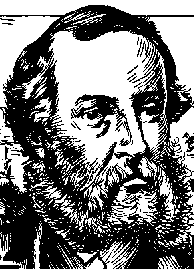Edward John Eyre was an explorer.
He born in England in 1815.
He came to Australia when he was seventeen.
There is a lake in South Australia that is named after him.
Edward John Eyre (1815 - 1901)
Edward John Eyre. Photo by Henry Hering c1870
Englishman Edward John Eyre (1815 - 1901) arrived in Australia in 1883, at the age of seventeen. In 1834 he acquired a 510 hectare property at Molonglo Plains, but struggled with sheep farming. He took his stock overland to Melbourne where he sold them at a profit and returned to Sydney.
He and some companions set out from Sydney heading for Adelaide. He was determined to find a way to cross the interior of the continent overland.
In 1839 Eyre left Adelaide to try to reach the centre of the continent. His way was blocked by swamps or sandhills, and Lake Torrens was mud, so he followed the Flinders Ranges to Mount Hopeless, and turned back.
Once back in Adelaide, he found that an expedition was being set up to open up a trail from Adelaide to Western Australia. Eyre was made leader of the expedition. The group consisted of six white men, including his friend John Baxter, and three Aboriginal people, including his friend Wylie. They took 13 horses, 40 sheep and supplies for three months. A government ship was to meet them at Spencer Gulf with more supplies.
They followed the coastline west, but it was hard going and they found little water along the way.
The coastline of the Nullarbor Plain is along the Great Australian Bight. ©iStock
At Fowler's Bay, Eyre decided to send some of the group back to Adelaide and to continue with a small group: his friends Baxter and Wylie, and the other two Aboriginal people. They took 11 horses and 6 sheep. There were no trees to shelter them along the Nullabor Plain and the heat was intense. They kept to the coastline, but could not reach the sea because of the high cliffs. There was little water.
Map of Eyre's expeditions (Wikipedia)
Finding water
They were saved by local Aboriginal people who showed them where to dig for water. They continued on and again were without water, but found some Aboriginal wells at the place now known as Eucla. They rested here and travelled on, keeping close to the beach. Again water became scarce, and local Aboriginal people taught them how to break off roots and suck them for moisture.
One by one the pack horses were left behind. The party used sponges to collect dew from plants in the mornings to ease their thirst. By the time they were halfway, it was winter and it was terribly cold at night. They had left most of their clothing, and guns and ammunition, with the abandoned pack horses. They had travelled about 1200 kilometres, and still had about 1000 more to go. The two Aboriginal guides rebelled, killed Baxter and took most of the remaining supplies and guns. Wylie and Eyre continued alone, but it was a week before they found water. They killed and ate kangaroos and other wildlife.
Eyre and Wylie finally met a French ship near the shore. They were able to rest there for a couple of weeks. Then they continued on, still heading westward, having been given clothing and supplies by the ship's captain.
The journey became easier, and in July 1841, they reached Albany, West Australia.
The journey had lasted four and a half months. Eyre was awarded a gold medal by the Royal Geographic Society.
In 1846, he became Lieutenant-Governor of New Zealand, and later Governor in the West Indies. He eventually returned to England, and died there in 1901. Wylie remained in Albany, reunited with his people. He was rewarded by being given a pension. (money)
Lake Eyre: South Australia
Lake Eyre is named for Eyre, who was the first European to see it.
Lake Eyre with water - a rare sight. Image ©iStock
It is Australia's largest salt lake. It is dry most of the time, but experiences a small flood every three years, a large flood every ten years, and fills only about four times each century. On those rare occasions, it is Australia's biggest lake.
Now officially known by its original name of Kati Thanda, Lake Eyre contains the lowest natural point in Australia, at approximately 15 metres below sea level.
The lake has been returned to its original owners, the Arabana people.
Most of the time Lake Eyre is a dry salt pan. ©iStock
It’s a good idea to get information from more than one source!
Read more about Lake Eyre
http://traveloutbackaustralia.com/lake-eyre-facts.html/







